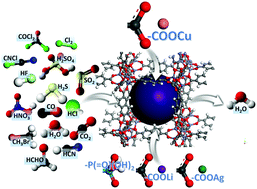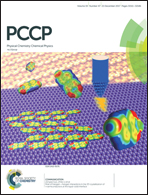Computational screening of functional groups for capture of toxic industrial chemicals in porous materials†
Abstract
A thermodynamic analysis using quantum chemical methods was carried out to identify optimal functional group candidates that can be included in metal–organic frameworks and activated carbons for the selective capture of toxic industrial chemicals (TICs) in humid air. We calculated the binding energies of 14 critical TICs plus water with a series of 10 functional groups attached to a naphthalene ring model. Using vibrational calculations, the free energies of adsorption were calculated in addition to the binding energies. Our results show that, in these systems, the binding energies and free energies follow similar trends. We identified copper(I) carboxylate as the optimal functional group (among those studied) for the selective binding of the majority of the TICs in humid air, and this functional group exhibits especially strong binding for sulfuric acid. Further thermodynamic analysis shows that the presence of water weakens the binding strength of sulfuric acid with the copper carboxylate group. Our calculations predict that functionalization of aromatic rings would be detrimental to selective capture of COCl2, CO2, and Cl2 under humid conditions. Finally, we found that forming an ionic complex, H3O+HSO4−, between H2SO4 and H2O via proton transfer is not favorable on copper carboxylate.



 Please wait while we load your content...
Please wait while we load your content...